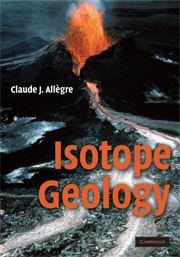Book contents
- Frontmatter
- Contents
- Preface
- Acknowledgments
- Isotopes and radioactivity
- The principles of radioactive dating
- Radiometric dating methods
- Cosmogenic isotopes
- Uncertainties and results of radiometric dating
- Radiogenic isotope geochemistry
- Stable isotope geochemistry
- Isotope geology and dynamic systems analysis
- References
- Appendix
- Further reading
- Solutions to problems
- Index of Names
- Subject Index
Radiometric dating methods
Published online by Cambridge University Press: 05 June 2012
- Frontmatter
- Contents
- Preface
- Acknowledgments
- Isotopes and radioactivity
- The principles of radioactive dating
- Radiometric dating methods
- Cosmogenic isotopes
- Uncertainties and results of radiometric dating
- Radiogenic isotope geochemistry
- Stable isotope geochemistry
- Isotope geology and dynamic systems analysis
- References
- Appendix
- Further reading
- Solutions to problems
- Index of Names
- Subject Index
Summary
We have so far examined the principles of radioactive dating with simple assumptions, namely that the initial amount of daughter isotope is negligible and that the system (mineral or rock) whose age is to be determined has remained closed since it first formed, that is, it has neither lost nor gained parent or daughter isotopes in the course of its geological past. These two conditions do not usually pertain in nature. So how can these difficulties be overcome?
General questions
Rich systems, poor systems
The dating equation showed that a distinction has to be made between systems with negligible initial radiogenic isotope and systems with abundant initial radiogenic isotope. In the first instance, that of a rich system (understood as radiogenically rich), an age can be calculated in theory from direct measurement of the parent and daughter isotopes. In the second instance, that of a poor system, some method must be found for estimating the initial abundance of the radiogenic isotope.
For a system to be considered rich, the radioactive isotope must be abundant compared with the radiogenic element. The chemical composition of the system under study must be such that the ratio of the radioactive isotope to the stable reference isotope is very high. The time for which it has been decaying must be long enough for radioactive disintegration to have produced enough of the radiogenic isotope.
Exercise
The [87Rb/86Sr] ratio in a biotite is 3000. Can a 300-million-year-old biotite be considered a rich system?
Answer
The [87Sr/86Sr] radiogenic ratio is written [87Sr/86Sr] ≈ [87Rb/86Sr] λt. […]
- Type
- Chapter
- Information
- Isotope Geology , pp. 58 - 104Publisher: Cambridge University PressPrint publication year: 2008



